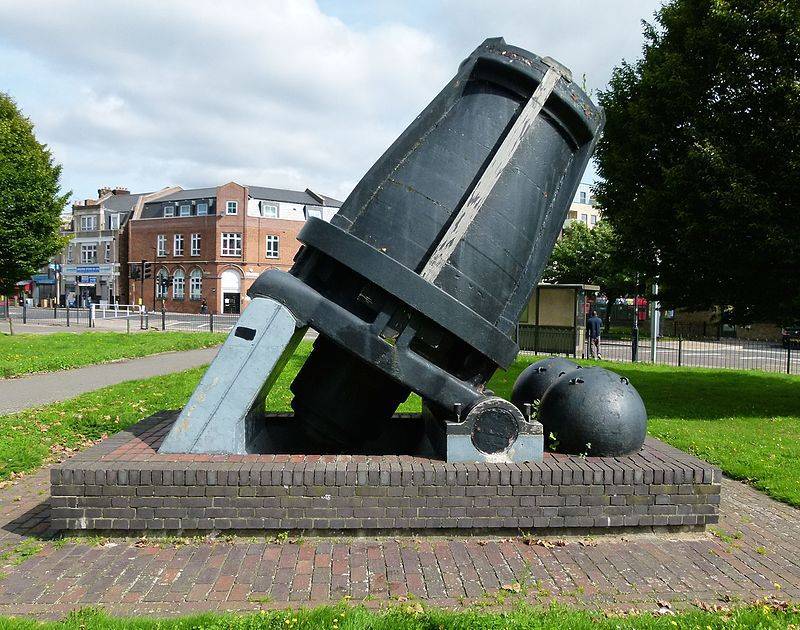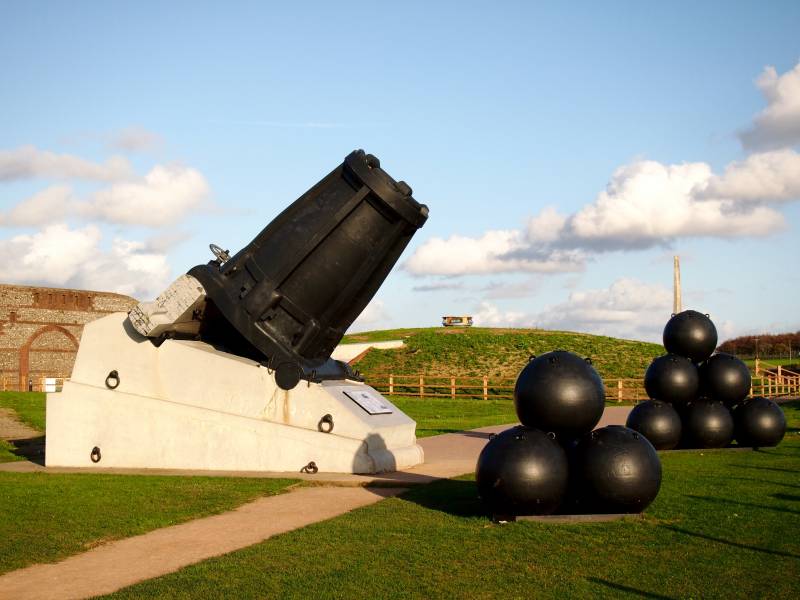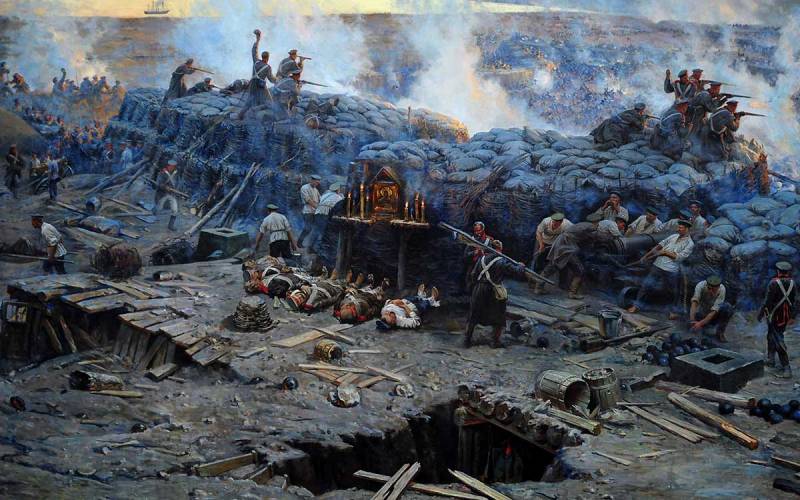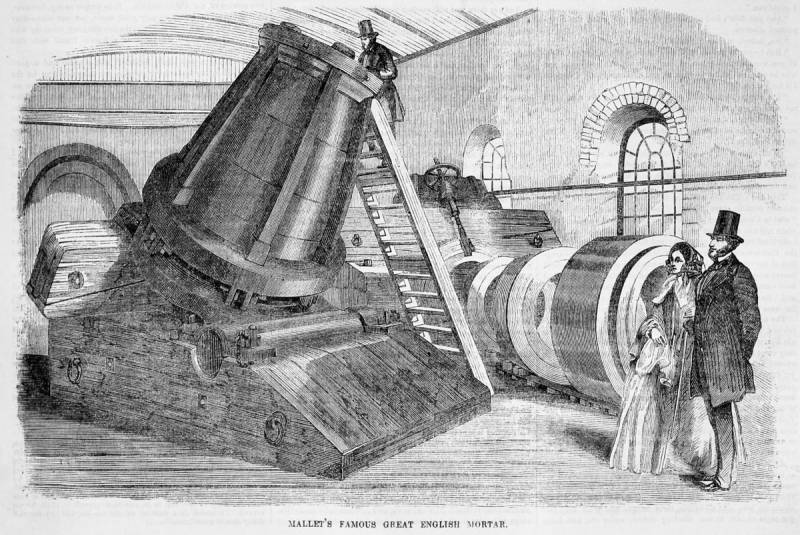"Tsar Cannon" from Britain. Mortira Malleta
The Tsar Cannon, which you must have seen in the Moscow Kremlin or in photographs, is not the only weapon of its kind. In the UK in 1854, designer Robert Mallet proposed creating a monstrous power to the mortar. While Mallet struggled with the British bureaucracy, the Crimean War, at which the mortars were supposed to take place, came to an end. Despite this, the project was brought to an end, but the military did not please the result. But many tourists are grateful to Mallet today for the wonderful scenery for Instagram. Both mortars built have survived to this day, and they are still very photogenic.
How Robert Mallet came up with the idea of creating a 914 mm mortar
The engineer of Great Britain of Irish descent, Robert Mallett, turned to the idea of creating a super-powerful mortar back in the 1850s. The impulse to work in this area was given by the Crimean War of 1853-1856, in the UK it is better known as the Eastern War, while in Russia it entered history called Crimean, as the main hostilities really unfolded in the Crimea. The British needed a new powerful mortar to cope with the fortifications and forts of Sevastopol, which could not be taken. It was the fight against fortifications that was the main task of the most powerful mortar in history.
At the time of the outbreak of the Eastern War, Great Britain had siege mortars, but the most powerful of them had a caliber of 13 inches (330 mm), which is already a lot, but the military wantedweapons. Sensing where the wind was blowing, Mallet intensified his work in the field of creating a super-powerful mortar, presenting the first draft of the future gun in October 1854. It should be noted here that Mallet came to the development of the mortar for a reason, wanting to earn money on the military department. For this, he had all the necessary skills and knowledge.
Back in the 30s and 40s of the XNUMXth century, Robert Mallett conducted numerous studies of the propagation of seismic waves from explosions in the ground. It was these of his studies that led the engineer to the idea of creating a huge mortar. In the future, Mallet wanted to achieve the same local effect in the explosion of a projectile that would be comparable to an earthquake. The specialist believed that such an approach is promising for the reason that the very need for accurate target hitting will disappear. A direct hit is actually quite rare luck, so he wanted to compensate for possible misses with the power of seismic vibrations, which would be enough to damage or completely destroy the fortification object. However, today many researchers believe that it was Robert Mallet who was one of the first engineers to seriously study the seismic effects of explosions.

Robert Mallett
In the middle of the XIX century, such an effect could be achieved only by combining two factors: the fall of a projectile from a very high height and giving it as much tangible mass as possible. The combination of these factors could provide a large penetration of the artillery shell into the ground with a subsequent explosion. This could be achieved by significantly increasing the caliber of the artillery mount and giving a large elevation angle to the gun. That is precisely the idea that was born to create a mortar with a trunk diameter of approximately 914 mm or 36 inches. At the same time, creating such a tool, the developer inevitably came across a problem of great weight, which also had to be solved somehow.
The difficulty of building a mortal of Mallet
The first draft of the mortars was completely ready by October 1854. The proposed option could not be called technological. Mallet suggested placing a 36-inch mortar without a standard base directly with emphasis on the platform. The platform, which was supposed to serve as a gun carriage, the designer proposed to build from three rows of roughly hewn logs laid crosswise. This design was to give the barrel an elevation angle of 45 degrees. The entire structure was planned to be placed on a site specially prepared and fortified during earthworks. During the design process, the mortar changed for the better. For example, Mallet was pointed out to consider the possibility of sea-based. Gradually, the designer expanded the capabilities of miracle weapons by providing the ability to move, using tools to change the angle of the gun, using large charges and increasing the volume of the chamber.
Robert Mallet held the first official presentation of the new mortar project on January 8, 1855. The engineer prepared the blueprints together with the accompanying notes for consideration by the Artillery Technical Upgrade Committee. Mallet did not receive the expected reaction. The committee reasonably doubted the prospects of such a mortar and was not ready for unconventional and untested projects, preferring more earthly models of artillery weapons. However, the inventor did not give up and decided to directly appeal to the most senior officials of the empire. Mallet did not trifle and at the end of March 1855 wrote a letter personally to the British Prime Minister. At that time, Lord Palmerston held the post.
Palmerston not only got acquainted with the received letter, but also admired the very idea that the engineer described. Later, he personally met with the designer and finally caught fire with the proposed idea. With such a patron, it seemed that things should go faster. However, the Committee for the Technical Re-equipment of Artillery continued to show its conservatism, deciding to make full use of all possible bureaucratic delays in order to slow down the consideration of the project and placing an order for the release of mortars. As subsequent events will show, in many respects the committee’s employees were right and simply didn’t want to let government money go down the drain. However, neither the prime minister nor the designer were going to give up. Mallett got a personal audience with the Prince Consort, making a trip to Windsor. A member of the royal family also decided that the project was worth trying to put it into practice. In turn, Palmerston put pressure on the lieutenant general of artillery, directly contacting Hugh Dalrymple Ross, the future British field marshal, on May 1, 1855.
It is important to understand here that the British army’s failures in Crimea most likely played a role in the promotion of the 914-mm mortars project. The assault on Sevastopol, which the troops of Great Britain, France and Turkey planned to complete within one week, resulted in a 349-day saga. This was the merit of the garrison of the city, the Black Sea sailors fleet, the population of Sevastopol, as well as skilled commanders: Kornilov, Nakhimov and Totleben. At the same time, the main merit of Count Eduard Ivanovich Totleben was that this talented military engineer in a short time managed to erect serious fortifications near the city, which the Allied armies stormed for 11 months. At the same time, the city and its defenders survived six large-scale bombings.
Under pressure from senior members of the government, the army, and the royal family, the Artillery Committee surrendered and began work by organizing a tender for the construction of Mullet’s mortar. On May 7, 1855, he was won by a Thames Iron Works company from Blackwell, which was ready to complete an order to build two mortars in 10 weeks. The announced price was approximately 4300 pounds per gun. Here the story repeated, which is familiar to many in the modern Russian system of public procurement. Most likely, the tender was won by the company that requested the lowest cost. However, already during the course of the work, it became clear that the company does not have all the necessary competencies and capabilities, the work was delayed, and the company itself went bankrupt in the process of work and began bankruptcy proceedings. As a result, the order was transferred to three other British firms.
The work was completed only 96 weeks after the receipt of the contract. Mortars were delivered in May 1857. At this point, not only the siege of Sevastopol ended, the Russian troops left the city on August 28, 1855, but also the Crimean War itself, a peace treaty was signed on March 18, 1856. Thus, Mallet’s mortars were late for the war, during which they could be used for their intended purpose.
The design of the 914-mm mortars
The project, developed by engineer Robert Mallet in the middle of the XIX century, provided for the creation of a mortar typical of that time, that is, a short-barreled gun, the barrel length was only 3,67 caliber. The gun was originally developed for firing at fortified positions and fortifications of the enemy along a steep hinged trajectory. The main feature of the project was a huge gun caliber for that time. At the same time, the Mallet project had a number of important interesting solutions. For example, Robert Mallet initially planned to make a mortar from several separate sections, which could be assembled already in place. Such a solution simplified the process of delivery and transportation of a huge heavy gun on the battlefield, especially in off-road conditions. The engineer also provided for the barrel’s engagement system. According to his idea, such a design was to increase the strength of a huge caliber gun due to shrinkage.
The barrel of Mallet’s 914-mm mortar consisted of a large number of parts, the weight of each of which made it possible to organize transportation in any way available at that time without significant difficulties. One of the features was that the charging chamber in Mallet’s mortar was substantially narrower than the main bore. The designer chose such a solution on the grounds that a small amount of powder charge would be enough to throw the ammunition at a distance of the alleged firing, which the mortars of those years were quite small.
Structurally, the mortar consisted of a cast base, the total weight of this cast-iron part was 7,5 tons. A trunnion, a flange and all the necessary devices for setting the required angle of inclination of the barrel were placed on the base. The chamber of the mortar was forged and made of wrought iron, the total weight of the element was 7 tons. The muzzle of the mortar consisted of three large composite rings of wrought iron. In this case, the three rings themselves were assembled from 21, 19 and 11 prefabricated rings. All of them were fastened with hoops, the largest of which had a diameter of 67 inches. Additionally, the construction was strengthened by six longitudinal rods of almost square cross section made of wrought iron. They combined the barrel ring and the cast base of the mortar. When assembled, Mallet’s 36-inch mortar weighed about 42 tons, while the heaviest part weighed no more than 12 tons.
Mortira Malleta, like the vast majority of the heavy artillery of Great Britain and other countries of the world at that time, was muzzle-loading. Bombs weighing from 1067 to 1334 kg were fed to the barrel of a huge gun with a winch. The bombs themselves were spherical and hollow inside. At the same time, the cavity itself was eccentric so that the bomb would not tumble in the air when it took off from the barrel.
Tests of Mullet's Mortar
Both mortars did not have time for the Sevastopol siege and in fact were not needed by the military, but they decided to conduct miracle weapon tests anyway. To conduct firing tests, one mortar was allocated. In total, the British military managed to produce a total of 19 shots. At the same time, the tests passed in 4 stages: October 19 and December 18, 1857 and July 21 and 28, 1858. The tests were organized at the Plumstead marshes training ground.

Mortira Malleta exhibited in Woolwich
At the completion of the tests, the 914-mm Mallet’s mortars used military munitions weighing 1088 kg. The maximum firing range that was achieved in the field conditions was 2759 yards (2523 meters). When flying at such a range, the ammunition was in the air for 23 seconds. The maximum rate of fire that was achieved during the tests was approximately four rounds per hour. According to the results of the tests, the military came to the conclusion that the mortars have no prospects for real combat use.
The decision is well-founded, given that each time the shooting was interrupted by breakdowns and subsequent repair of the mortars. During the first firing, only 7 shots were fired, after which a crack formed on one of the outer rings of the barrel. The second time the tests were stopped after 6 shots, this time the cause was the rupture of the central hoop tightening the lower ring. In the future, malfunctions continued to occur, although for the third firing the military switched to lighter ammunition weighing 2400 pounds (1088 kg), with which the best result was achieved firing range. Despite the fact that the mortar remained maintainable, the military decided to abandon further tests, spending a total of 14 thousand pounds on the project.
In fairness, it is worth noting that a number of historians believe that the main reason for the frequent breakdowns of the mortar during the tests was not the unsuccessful design proposed by the engineer, but the poor quality of the metal used and the low level of production culture. It was not possible to improve the properties and qualities of the metal used in the manufacture of the barrel in the mid-XNUMXth century and at the current level of development of metallurgy, science and technology.



Information